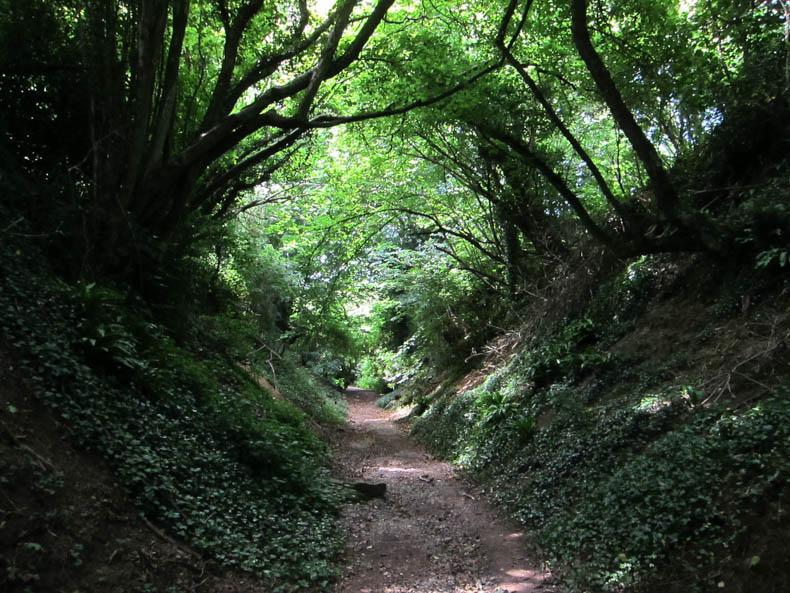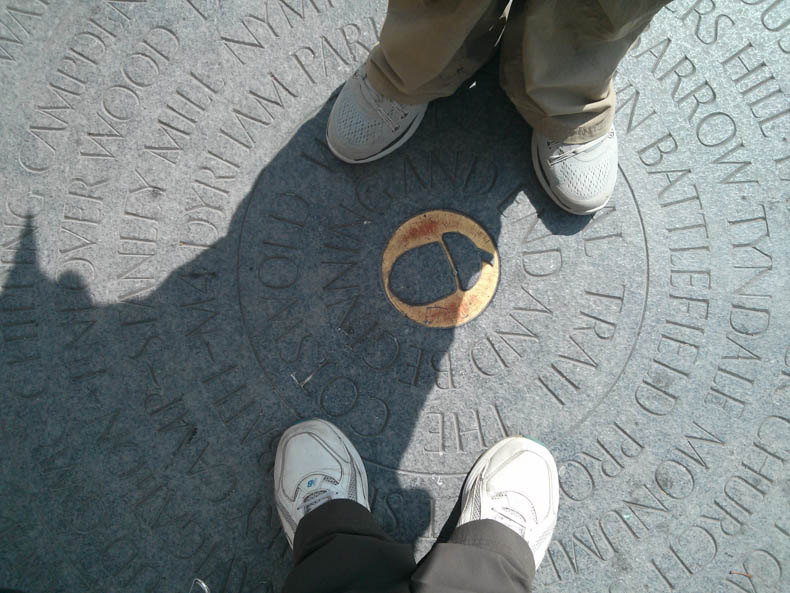
I love walking.
This seems like such a silly thing to say, like “I love breathing.” We’re humans, you and me. Walking is our thing. Being bipedal makes us us. But walking is also an activity that I love. It takes me places, it shows me things, it gives me ideas, it calms my nerves. So I was pleased to discover that someone had written a whole book about it: Wanderlust: A History of Walking, by Rebecca Solnit, published in 2000.
In her chapter on Pilgrimage, Solnit mentions the idea of a liminal state. This is an in-between place, where you don’t have family responsibilities or rank; instead of your regular life, you are in a state of possibility. It comes from the Latin limin, threshold. When you’re a pilgrim, you have stepped out of the secular world, over the threshold into this other world.
In the summer of 2013, a friend and I went for a week-long walk along the Cotswold Way, one of the United Kingdom’s National Trails. It wanders north-south through the Cotswolds, a picturesque region of sheep and rolling hills. The trail mostly follows the Cotswold escarpment, a long stretch of hard limestone, laid down in the shallow, warm seas of the Jurassic. To the west lie the flat plains of the River Severn. To the east, the land slopes gently off to Oxford and London.
We entered this narrow belt of in-between via a 15-minute cab ride, from a sketchy pub next to the Gloucester train station – there were neck tattoos – to a bed and breakfast in the home of two elderly sisters who had been born in the house next door. Their family’s farm lay in a valley bordered on three sides by the escarpment.
At that point the escarpment is too steep for houses or farming. It is dotted with landslides, pocked with quarries, and densely covered with trees. The next morning we crossed the fields to this scarp, and for the rest of the week we walked along it. We walked up and down the slope, diagonally through the trees, several times a day, on a way cobbled together from what seemed to be ancient cow paths. At times the banks and tree roots hung far above our heads. Those ascents and descents often seemed pointless. We named the trail “Jerry” so we could swear at it.
Before the trip, I read a review of the trail in which the writer complained that, while the region is jam-packed with charming villages, this trail was routed to miss almost every single one of them. Most of the time we were in the trees or the fields. Wild garlic grew along the trails, where the woods shaded us from the surprisingly fierce summer sun.
 It wasn’t the sacred space of a pilgrimage; this was only the vacation world. But it did feel like a separate place. For nearly 70 miles our feet carried us up and down, across the fields, over gates and stiles. At this ancient, human pace, I saw the shifts and bulges of the countryside, the slowly changing vistas, the lay of the land.
It wasn’t the sacred space of a pilgrimage; this was only the vacation world. But it did feel like a separate place. For nearly 70 miles our feet carried us up and down, across the fields, over gates and stiles. At this ancient, human pace, I saw the shifts and bulges of the countryside, the slowly changing vistas, the lay of the land.
I didn’t realize how different this space was until we left it. On our last day, we walked along a narrow finger of high land, then descended into the outer edges of Bath, over more stiles, through suburbia, across a beautiful Georgian park, past Bath’s iconic Royal Crescent. We wound through streets of adorable shops and lost track of the trail’s acorn markers. As the crowds grew, I realized how sweaty I was, and that I’d been wearing the same grubby brown hiking pants all week.
 We reached our goal, the marker that marks the southern terminus of the Cotswold Way. After a week on the escarpment, between the barley fields and the cows, we stood, grinning, like shabby woodland spirits among the people with their shopping bags and clean clothes. No one else was impressed, but it seemed like we’d pulled off something magical and strange, replacing a drive of a little over an hour with days and days slogging up and down hills and a lot of pub lunches. This little in-between stretch of England was now, somehow, mine; I’d traced it on topographic maps and trodden it with my feet.
We reached our goal, the marker that marks the southern terminus of the Cotswold Way. After a week on the escarpment, between the barley fields and the cows, we stood, grinning, like shabby woodland spirits among the people with their shopping bags and clean clothes. No one else was impressed, but it seemed like we’d pulled off something magical and strange, replacing a drive of a little over an hour with days and days slogging up and down hills and a lot of pub lunches. This little in-between stretch of England was now, somehow, mine; I’d traced it on topographic maps and trodden it with my feet.
We took a few photos of beautiful Bath Abbey, a church built from that local limestone, walked to the nearest taxi stand, and caught a ride to our hotel, hot showers, and our own transformations back into people of the regular world.
Photos: Helen Fields
Finally, a LWON based on a place I’ve actually been, as opposed to a desert somewhere. I live in Stonehouse, one of the not-so-charming Cotswold towns you would have walked through (you could have re-directed through Painswick or Michinhampton if you wanted one of those). Though, obviously, having lived here for 10 years, I’ve never walked the Cotswold Way for more than a day’s worth.
Oh yes! I don’t remember Stonehouse, but a glance at Google Maps suggests that we crossed the train tracks on a bridge just east of you. We walked through Painswick the day before. We saw very few people who appeared to be walking long stretches of the Cotswold Way – in fact, maybe just one man. Isn’t it nice to know that you *could* walk out your front door and end up in Bath, though?